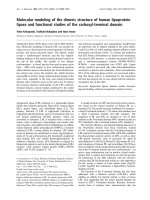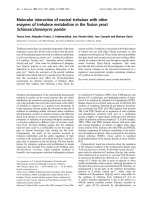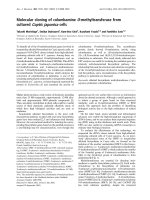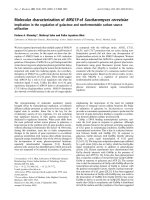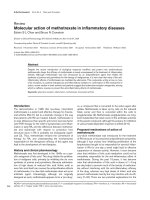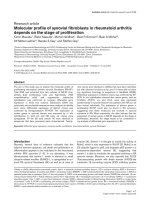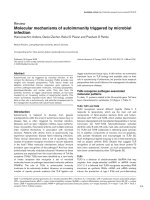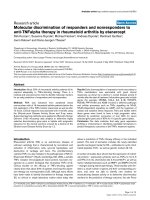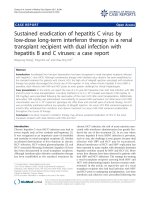Báo cáo y học: "Molecular Virology of Hepatitis C Virus (HCV): 2006 Update"
Bạn đang xem bản rút gọn của tài liệu. Xem và tải ngay bản đầy đủ của tài liệu tại đây (1.14 MB, 6 trang )
Int. J. Med. Sci. 2006, 3
29
International Journal of Medical Sciences
ISSN 1449-1907 www.medsci.org 2006 3(2):29-34
©2006 Ivyspring International Publisher. All rights reserved
Review
Molecular Virology of Hepatitis C Virus (HCV): 2006 Update
Volker Brass
1
, Darius Moradpour
2
and Hubert E. Blum
1
1. Department of Medicine II, University of Freiburg, D-79106 Freiburg, Germany
2. Division of Gastroenterology and Hepatology, Centre Hospitalier Universitaire Vaudois, University of Lausanne, CH-1011
Lausanne, Switzerland
Corresponding address: Hubert E. Blum, M.D., Department of Medicine II, University of Freiburg, Hugstetter Strasse 55, D-79106
Freiburg, Germany. Tel. +49 761 270 3403. Fax +49 761 270 3610. E-mail:
Received: 2005.12.30; Accepted: 2006.03.10; Published: 2006.04.01
Fascinating progress in the understanding of the molecular biology of hepatitis C virus (HCV) was achieved recently.
The replicon system revolutionized the investigation of HCV RNA replication and facilitated drug discovery. Novel
systems for functional analyses of the HCV glycoproteins allowed the validation of HCV receptor candidates and the
investigation of cell entry mechanisms. Most recently, recombinant infectious HCV could be produced in cell culture,
rendering all steps of the viral life cycle, including entry and release of viral particles, amenable to systematic analysis.
In this review, we summarize recent advances and discuss future research directions.
Key words: helicase, hepatitis C virus, protease, polymerase, replicon
1. Introduction
The hepatitis C virus (HCV) belongs to the Flaviviridae family and is the only member of the Hepacivirus genus.
HCV infection is a major cause of chronic hepatitis, liver cirrhosis, and hepatocellular carcinoma (HCC) worldwide [1].
Therapeutic options are improving but are still limited and a protective vaccine is not available to date. In 50% to 80%
acute HCV infection persists and 4% to 20% of patients with chronic hepatitis C will develop liver cirrhosis within 20
years. In patients with liver cirrhosis, the risk to develop HCC is 1-5% per year. Current standard therapy is the
combination of pegylated interferon-α (PEG-IFN-α) and ribavirin. Depending on the HCV genotype and other factors,
this strategy results in a sustained virologic response in 50-80% of patients [2-5]. However, many patients do not qualify
for or do not tolerate standard therapy [6]. Therefore, more effective and better tolerated therapeutic strategies are
urgently needed. The development of such strategies depends on a detailed understanding of the molecular virology of
HCV infection.
The investigation of the HCV life cycle and pathogenesis has been complicated by the lack of efficient cell culture
systems and small animal models. Nevertheless, significant progress could be made using heterologous expression
systems, functional cDNA clones [7], the replicon system [8, 9], and functional HCV pseudoparticles [10, 11] (see refs.
[12-14] for reviews). Most recently, a major milestone was the production of recombinant infectious HCV particles in cell
culture [15-17]. The model systems, summarized in Table 1, are the current basis for the study of the HCV life cycle and
the development of novel antiviral strategies.
Table 1. In vitro and in vivo models to study HCV.
Int. J. Med. Sci. 2006, 3
30
Figure 1. Life cycle of HCV. The steps of the viral life cycle are depicted schematically. The topology of HCV structural and
nonstructural proteins at the endoplasmic reticulum (ER) membrane is shown. HCV RNA replication occurs in a specific membrane
alteration, the membranous web (MW). IRES-mediated translation and polyprotein processing as well as membranous web
formation and RNA replication, illustrated here as separate steps for simplicity, may occur in a tightly coupled manner.
2. The replicon system
For many years, HCV research was hampered by the extremely restricted host range and the inefficiency of in vitro
models based on the incubation of cells in culture with HCV particles. Therefore, the establishment of a replicon system
for HCV was a milestone in HCV research [8, 18]. The prototype subgenomic replicon utilized a particular HCV
genotype 1b clone termed Con1. In this system, the structural region was replaced by the sequence encoding the
neomycin phosphotransferase gene resulting in G418 resistance. Expression of the nonstructural proteins is directed by
a heterologous encephalomyocarditis virus (EMCV) internal ribosomal entry site (IRES) downstream of the neomycin
phosphotransferase gene. After transfection into the human HCC cell line Huh-7 G418 resistant colonies contain self-
replicating HCV RNA. Critical for the usefulness of this system was the identification of specific amino acid
substitutions, i.e., cell culture-adaptive changes, that increased the efficiency of replication initiation by several orders of
magnitude [9]. With the replicon system it became possible, for the first time, to study efficient and genuine HCV RNA
replication in vitro as well as structural aspects of the replication complex, basic replication processes, virus-host cell
interactions, and antiviral agents.
In the last 6 years, a large panel of different replicon systems has been developed (Fig. 2). These include replicons
from genotype 1a [19] and 2a [20], transient systems expressing easily quantifiable marker enzymes [21], replicons with
green fluorescent protein (GFP) insertions in NS5A to track replication complexes in living cells [22], and full length
replicons. In addition, the spectrum of permissive host cells has been expanded [23].
The replicon system revolutionized the research on basic replication processes. However, the step of infection and
entry as well as the release of viral progeny could not be analysed to date. Wakita and colleagues, however, generated a
genotype 2a replicon (JFH-1) that was isolated from the serum of a patient with fulminant hepatitis C [20]. This system
turned out to replicate very efficiently in different cell types. Furthermore, the full-length JFH-1 sequence produced
infectious viral particles that could be passaged in cell culture [15, 17]. Further, chimeric constructs with the structural
region of the J6 genotype 2a clone improved the infectivity of this system significantly [16]. This recombinant infectious
HCV cell culture system represents the last major milestone in the field and renders the complete viral life cycle
accessible to detailed analysis in vitro.
3. Cell entry
Surrogate models for the study of the early steps of viral life cycle have been established, including infectious
retroviral pseudotypes displaying functional HCV glycoproteins. These pseudotypes turned out to provide a robust
model system for the study of viral entry [10, 11]. HCV pseudoparticle infectivity is pH-dependent and restricted
primarily to human hepatocytes and hepatocyte-derived cell lines. Thus, HCV entry likely involves transit through an
endosomal, low pH compartment and fusion with the endosomal membrane.
HCV E2 binds with high affinity to the large external loop of CD81, a tetraspanin found on the surface of many cell
types including hepatocytes [24]. However, CD81 is not sufficient to mediate cell entry and several cofactors appear to
be required. The low density lipoprotein receptor (LDLR) [25] and scavenger receptor class B type I (SR-BI) [26] have,
among others, been proposed as components of a putative HCV receptor complex. The concept, that lipoproteins could
play an important role for cell entry is supported by recent data from studies on HCV pseudotypes that demonstrate an
enhancement of infectivity by certain components of human serum [27, 28]. In particular, association to high density
lipoprotein (HDL) seems to enhance SR-BI guided cell entry and could protect viral particles from neutralizing
antibodies [29].
Int. J. Med. Sci. 2006, 3
31
Figure 2. Comparison of different replicon systems. A selection of different bicistronic and monocistronic replicon constructs
including subgenomic and full-length HCV sequences is depicted schematically. Stably replicating systems are equipped among
others with a neomycin phosphotransferase or a hygromycin phosphotransferase cassette that allow selection of cells with
continuous RNA replication. Transient systems include a marker gene that allows quantification 48 h after transient transfection. In
general, luciferase (Luc) is used as easily quantifiable enzyme in this context and values are normalized based on the amount of
input RNA. Monocistronic replicon constructs avoid the translation of proteins from the heterologous encephalomyocarditis virus
(EMCV) IRES. The resistance gene is released after cleavage via a ubiquitin sequence (Ubi).
4. Translation and polyprotein processing
The HCV genome consists of a 9.6-kb positive-strand
RNA that comprises a long open reading frame flanked by
5' and 3' noncoding regions (NCR). The 5' NCR is highly
conserved among different HCV isolates and contains an
IRES. The IRES directly binds the 40S ribosomal subunit
independently of the pre-initiation factors necessary for
cap-dependent translation. The three-dimensional
structure of the HCV IRES bound to the 40S ribosomal
subunit illustrates the molecular basis of this cap-
independent translation process [30]. High-resolution
structural data on critical elements of the IRES and
detailed characterization of the translation initiation
complex further improves the view on the HCV
translation initiation [31, 32].
Translation of the HCV genome leads to a
polyprotein precursor that is co- and post-translationally
processed by cellular and viral proteases to produce the
mature structural and nonstructural proteins. The N-
terminal one-third of the polyprotein harbors the
structural proteins core, E1 and E2 that form the viral
particle. The structural region is followed by the p7
polypeptide which may be involved in ion channel
formation (see below). The nonstructural proteins 2-5B
coordinate viral replication by the formation of a
membrane-bound replication complex. Processing of the
polyprotein at the core/E1, E1/E2, E2/p7, and p7/NS2
sites by the host cell signal peptidase produces all
structural proteins and p7. Two viral proteases are
responsible for the maturation of the nonstructural
proteins. The NS2-3 autoprotease cleaves at the NS2/NS3
junction while all downstream sites are processed by the
NS3-4A serine protease.
5. Molecular aspects of viral proteins
5.1 Structural proteins
5.1.1 Core protein
The HCV core protein is a highly basic, RNA-binding
protein which presumably forms the viral nucleocapsid.
Of note, the core protein has been reported to interact
with numerous cellular proteins and to affect host cell
functions such as gene transcription, lipid metabolism,
apoptosis and various signaling pathways [33]. Further, it
has been associated with the induction of steatosis and
HCC [34-36].
5.1.2 Envelope glycoproteins
The envelope glycoproteins E1 and E2 are type I
transmembrane proteins with C-terminal hydrophobic
anchors. The ectodomains translocate to the ER lumen
where they are modified by extensive N-linked
glycosylation. E1 and E2 form non-covalent heterodimers
which are believed to represent the building blocks for the
viral envelope. The processes of particle assembly and
release are poorly understood and have only recently
become amenable to systematic investigation. In this
context, structural studies on recombinant HCV particles
confirmed earlier electron microscopy observations [15].
5.2 ARFP/F protein
The synthesis of a protein encoded by an alternative
reading frame within the core region was reported by
several groups [37]. It was designated ARFP (alternative
reading frame protein) or F (frameshift) protein and
comprises up to 160 amino acids. The ARFP/F protein is
dispensable for HCV RNA replication. Whether it is
expressed during natural HCV infection has still to be
clarified.
Int. J. Med. Sci. 2006, 3
32
5.3 p7
p7 is a 63-amino acid polypeptide located at the
junction between the structural and nonstructural region.
It is unknown whether p7 is packaged into viral particles.
It is composed of two transmembrane domains and has
recently been reported to form hexamers with ion channel
activity [38, 39]. It is believed that p7 could be important
for viral assembly because the corresponding protein of
the related bovine viral diarrhea virus (BVDV) is essential
for the production of infectious progeny virus but not for
RNA replication [40].
5.4 Nonstructural proteins
5.4.1 NS2-3 autoprotease
The NS2/3 junction is cleaved by a remarkable
autoprotease consisting of NS2 and the N-terminal third
of NS3. Although NS2-3 protease activity is required for
the replication in vivo, it is dispensable for replication of
subgenomic replicons in vitro. It is unclear whether NS2
fulfills any further functions after separation from NS3.
5.4.2 NS3-4A
NS3 is a multifunctional protein because it harbors a
serine protease located in the N-terminal one-third that is
responsible for the downstream cleavage in the
nonstructural region and a NTPase/RNA helicase domain
in the C-terminal two-thirds. NS4A, a 54-amino acid
polypeptide, targets NS3 to intracellular membranes and
is required as a cofactor for the NS3 serine protease. The
crystal structure of the NS3-4A complex revealed that
NS4A is an integral component of the enzyme core [41].
Surprisingly, the NS3 serine protease recently turned out
to influence the innate cellular host defense by inhibition
of RIG-I and TLR3 signalling [42, 43]. This observation
renders the NS3 protease particularly attractive as an
antiviral target [44]. Serine protease inhibitors have
emerged as extremely efficient antiviral components in
first 'proof-of-principle' studies in patients with chronic
hepatitis C [45, 46].
The enzymatic activity of the NS3 NTPase/helicase
activity is indispensable for RNA replication. Putative
functions during replication could be to unwind
replicative double strand RNA intermediates, to eliminate
RNA secondary structures or to separate the genome from
nucleic acid binding proteins. Recent advances in the
understanding of the molecular mechanisms of this
enzyme could enable a specific inhibition as a novel
antiviral strategy [47, 48].
5.4.3 NS4B
Due to its very hydrophobic properties, NS4B
belongs to the difficult-to-study HCV proteins that are
poorly understood. So far, it is known that NS4B is a 27-
kDa integral membrane protein that localizes to an ER-
derived membranous compartment [49]. Interestingly, the
expression of NS4B induces a specific membrane
alteration, designated as membranous web, that serves as
a scaffold for the formation of the viral replication
complex [50, 51].
5.4.4 NS5A
NS5A is a phosphorylated zinc metalloprotein of
unknown function. Numerous potential functions and a
huge list of interaction partners have been described [33].
However, suprisingly little efforts has been devoted to a
rigorous biochemical characterization of this protein and
its definitive role in viral replication remains elusive.
NS5A has initially attracted considerable interest because
of its potential role in modulating the IFN response
(reviewed in ref. [52]). These findings are still
controversial, however. A striking observation was the
concentration of cell culture adaptive replicon mutations
within the central part of NS5A [9, 53]. Considering the
fact that NS5A phosphorylation has an impact on
replication efficiency, these observations support the
concept that NS5A plays an important role in the
regulation of viral replication [54-56]. The membrane
association of NS5A is mediated by a unique amphipathic
alpha-helix which is localized at the N-terminus [57, 58].
Limited proteolysis experiments recently allowed the
definition of three protein domains within the cytosolic
domain [59]. More recently, the three-dimensional
structure of the N-terminal domain I could be resolved by
crystallography. After dimerization, it forms a basic
groove facing the cytosol at the surface of the membrane
[60]. This 'claw like' structure is believed to provide an
RNA binding site that could be involved in regulated
genome targeting within the replication complex.
5.4.5 NS5B
The key enzyme of the replicase that promotes
synthesis of new RNA genomes is the NS5B RNA-
dependent RNA polymerase (RdRp). NS5B is a tail-
anchored protein, characterized by a transmembrane
domain at the C-terminus of the protein responsible for
posttranslational membrane targeting [61-63]. The
structural organization of NS5B is a typical 'right hand'
polymerase shape with finger, palm, and thumb
subdomains surrounding a completely encircled active
site [64]. Replication proceeds via synthesis of a
complementary minus-strand RNA using the genome as a
template and the subsequent synthesis of genomic plus-
strand RNA from this minus-strand RNA intermediate.
As central component of the HCV replicase, NS5B has
emerged as a major target for antiviral intervention [44].
6. RNA replication
As in all positive-strand RNA viruses investigated
thus far (reviewed in ref. [65]), HCV forms a membrane-
associated replication complex, composed of viral
proteins, replicating RNA, altered cellular membranes
and additional host cell factors [50, 51]. A specific
membrane alteration, referred to as the membranous web,
was recently identified as the site of RNA replication in
Huh-7 cells harboring subgenomic HCV replicons [51].
Thus, intracellular membranes play a crucial role in HCV
replication. Recent data underline the importance of a
specific lipid environment for HCV RNA replication [66,
67].
In addition to coordinated protein-protein and
protein-membrane interaction, essential cis-acting
replication elements (CRE) of the RNA genome were
recently discovered. For instance, the sequence coding for
the C-terminal domain of NS5B consists of an essential
stem-loop, designated SL3.2, within a larger cruciform
RNA element, designated SL3 [68]. Detailed
characterization of the SL3.2 domain indicated a
functionally important kissing loop interaction with the 3'
NCR [69].
Several host cell factors, including hVAP-A, FBL2 or
cyclophylin B that influence HCV RNA replication via
interaction with different viral proteins have been
Int. J. Med. Sci. 2006, 3
33
identified [54, 70, 71]. However, the regulation of
replication, the switch to translation or assembly and the
release of viral particles are still poorly understood.
7. Future research directions
The pace of research in the HCV field has increased
enormously with the establishment of the replicon system.
The infectious JFH-1 cell culture system promises exiting
progress in the understanding of steps in the viral life
cycle that have been difficult to study thus far. In
particular, HCV entry, cytoplasmic release and uncoating,
the initial steps of replication, virus assembly, the release
of viral progeny, and the detailed virion structure will be
characterized in the infectious cell culture system.
Furthermore, the impact of viral proteins such as p7 and
NS2 for viral particle formation and possibly of NS5A for
the switch between replication and assembly can be
explored in this context. New insights into the molecular
virology of HCV should identify novel targets for antiviral
strategies.
Conflict of interest
The authors have declared that no conflict of interest
exists.
References
1. [No authors listed]. National Institutes of Health Consensus
Development Conference Statement: Management of hepatitis C
2002 (June 10-12, 2002). Gastroenterology 2002; 123: 2082-99.
2. Manns MP, McHutchison JG, Gordon SC, Rustgi VK, Shiffman M, et
al. Peginterferon alfa-2b plus ribavirin compared with interferon
alfa-2b plus ribavirin for initial treatment of chronic hepatitis C: a
randomised trial. Lancet 2001; 358: 958-65.
3. Fried MW, Shiffman ML, Reddy KR, Smith C, Marinos G, et al.
Peginterferon alfa-2a plus ribavirin for chronic hepatitis C virus
infection. N Engl J Med 2002; 347: 975-82.
4. Hadziyannis SJ, Sette HJr., Morgan TR, Balan V, Diago M, et al.
Peginterferon-alpha2a and ribavirin combination therapy in chronic
hepatitis C: a randomized study of treatment duration and ribavirin
dose. Ann Intern Med 2004; 140: 346-55.
5. Muir AJ, Bornstein JD and Killenberg PG. Peginterferon alfa-2b and
ribavirin for the treatment of chronic hepatitis C in blacks and non-
Hispanic whites. N Engl J Med 2004; 350: 2265-71.
6. Falck-Ytter Y, Kale H, Mullen KD, Sarbah SA, Sorescu L, et al.
Surprisingly small effect of antiviral treatment in patients with
hepatitis C. Ann Intern Med 2002; 136: 288-92.
7. Kolykhalov AA, Agapov EV, Blight KJ, Mihalik K, Feinstone SM, et
al. Transmission of hepatitis C by intrahepatic inoculation with
transcribed RNA. Science 1997; 277: 570-4.
8. Lohmann V, Korner F, Koch J, Herian U, Theilmann L, et al.
Replication of subgenomic hepatitis C virus RNAs in a hepatoma cell
line. Science 1999; 285: 110-3.
9. Blight KJ, Kolykhalov AA and Rice CM. Efficient initiation of HCV
RNA replication in cell culture. Science 2000; 290: 1972-4.
10. Bartosch B, Dubuisson J and Cosset FL. Infectious hepatitis C virus
pseudo-particles containing functional E1-E2 envelope protein
complexes. J Exp Med 2003; 197: 633-42.
11. Hsu M, Zhang J, Flint M, Logvinoff C, Cheng-Mayer C, et al.
Hepatitis C virus glycoproteins mediate pH-dependent cell entry of
pseudotyped retroviral particles. Proc Natl Acad Sci U S A 2003; 100:
7271-6.
12. Bartenschlager R, Frese M and Pietschmann T. Novel insights into
hepatitis C virus replication and persistence. Adv Virus Res 2004; 63:
71-180.
13. Penin F, Dubuisson J, Rey FA, Moradpour D and Pawlotsky JM.
Structural biology of hepatitis C virus. Hepatology 2004; 39: 5-19.
14. Lindenbach BD and Rice C. Unravelling hepatitis C virus replication
from genome to function. Nature 2005; 436: 933-938.
15. Wakita T, et al. Production of infectious hepatitis C virus in
tissue culture from a cloned viral genome. Nature Med. 2005 11 :791–
96
16. Lindenbach BD, Evans MJ, Syder AJ, Wolk B, Tellinghuisen TL, et al.
Complete replication of hepatitis C virus in cell culture. Science 2005
309 :623–26
17. Zhong J, Gastaminza P, Cheng G, Kapadia S, Kato T, et al. Robust
hepatitis C virus infection in vitro. Proc Natl Acad Sci. USA 2005 102
:9294–99
18. Bartenschlager R. The hepatitis C virus replicon system: from basic
research to clinical application. J Hepatol 2005; 43: 210-6.
19. Blight KJ, McKeating JA, Marcotrigiano J and Rice CM. Efficient
replication of hepatitis C virus genotype 1a RNAs in cell culture. J
Virol 2003; 77: 3181-90.
20. Kato T, Date T, Miyamoto M, Furusaka A, Tokushige K, et al.
Efficient replication of the genotype 2a hepatitis C virus subgenomic
replicon. Gastroenterology 2003; 125: 1808-17.
21. Krieger N, Lohmann V and Bartenschlager R. Enhancement of
hepatitis C virus RNA replication by cell culture-adaptive mutations.
J Virol 2001; 75: 4614-24.
22. Moradpour D, Evans MJ, Gosert R, Yuan Z, Blum HE, et al. Insertion
of green fluorescent protein into nonstructural protein 5A allows
direct visualization of functional hepatitis C virus replication
complexes. J Virol 2004; 78: 7400-9.
23. Zhu Q, Guo JT and Seeger C. Replication of hepatitis C virus
subgenomes in nonhepatic epithelial and mouse hepatoma cells. J
Virol 2003; 77: 9204-10.
24. Pileri P, Uematsu Y, Campagnoli S, Galli G, Falugi F, et al. Binding of
hepatitis C virus to CD81. Science 1998; 282: 938-41.
25. Agnello V, Abel G, Elfahal M, Knight GB and Zhang QX. Hepatitis C
virus and other flaviviridae viruses enter cells via low density
lipoprotein receptor. Proc Natl Acad Sci U S A 1999; 96: 12766-71.
26. Scarselli E, Ansuini H, Cerino R, Roccasecca RM, Acali S, et al. The
human scavenger receptor class B type I is a novel candidate
receptor for the hepatitis C virus. Embo J 2002; 21: 5017-25.
27. Meunier JC, Engle RE, Faulk K, Zhao M, Bartosch B, et al. Evidence
for cross-genotype neutralization of hepatitis C virus pseudo-
particles and enhancement of infectivity by apolipoprotein C1. Proc
Natl Acad Sci U S A 2005; 102: 4560-5.
28. Lavillette D, Morice Y, Germanidis G, Donot P, Soulier A, et al.
Human serum facilitates hepatitis C virus infection, and neutralizing
responses inversely correlate with viral replication kinetics at the
acute phase of hepatitis C virus infection. J Virol 2005; 79: 6023-34.
29. Bartosch B, Verney G, Dreux M, Donot P, Morice Y, et al. An
interplay between hypervariable region 1 of the hepatitis C virus E2
glycoprotein, the scavenger receptor BI, and high-density lipoprotein
promotes both enhancement of infection and protection against
neutralizing antibodies. J Virol 2005; 79: 8217-29.
30. Spahn C M, Kieft JS, Grassucci RA, Penczek PA, Zhou K, et al.
Hepatitis C virus IRES RNA-induced changes in the conformation of
the 40s ribosomal subunit. Science 2001; 291: 1959-62.
31. Kieft JS, Zhou K, Grech A, Jubin R and Doudna JA. Crystal structure
of an RNA tertiary domain essential to HCV IRES-mediated
translation initiation. Nat Struct Biol 2002; 9: 370-4.
32. Otto GA and Puglisi JD. The pathway of HCV IRES-mediated
translation initiation. Cell 2004; 119: 369-80.
33. Tellinghuisen TL and Rice CM. Interaction between hepatitis C virus
proteins and host cell factors. Curr Opin Microbiol 2002; 5: 419-27.
34. Moriya K, Fujie H, Shintani Y, Yotsuyanagi H, Tsutsumi T, et al. The
core protein of hepatitis C virus induces hepatocellular carcinoma in
transgenic mice. Nat Med 1998; 4: 1065-7.
35. Hope RG, Murphy DJ and McLauchlan J. The domains required to
direct core proteins of hepatitis C virus and GB virus-B to lipid
droplets share common features with plant oleosin proteins. J Biol
Chem 2002; 277: 4261-70.
36. Lerat H, Honda M, Beard MR, Loesch K, Sun J, et al. Steatosis and
liver cancer in transgenic mice expressing the structural and
nonstructural proteins of hepatitis C virus. Gastroenterology 2002;
122: 352-65.
37. Branch AD, Stump DD, Gutierrez JA, Eng F and Walewski JL. The
hepatitis C virus alternate reading frame (ARF) and its family of
novel products: the alternate reading frame protein/F-protein, the

